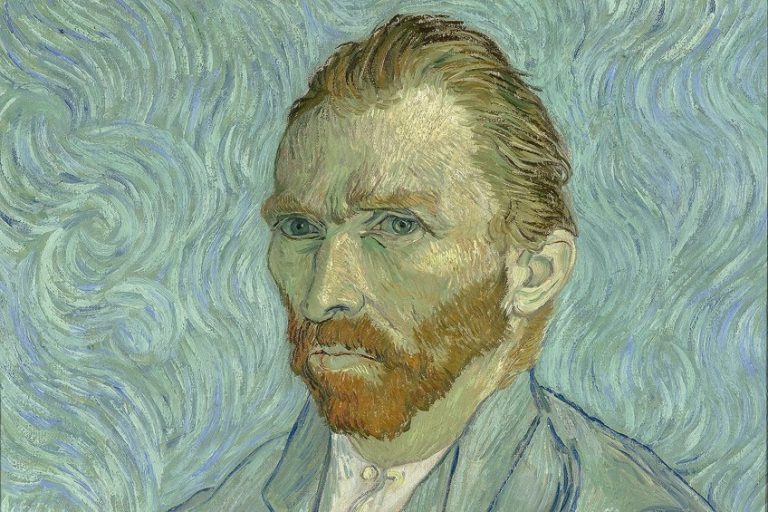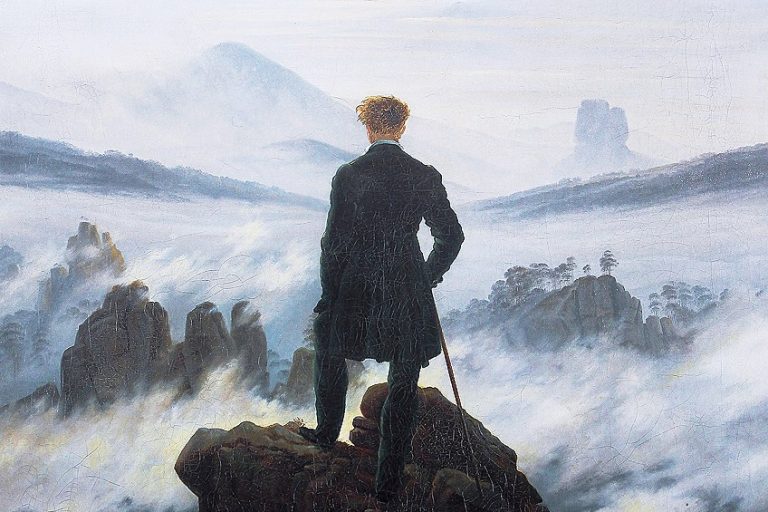“A Bar at the Folies-Bergère” by Édouard Manet – A Look
Imagine being transported to a 19th-century music hall with bustling crowds, jolly music, swinging trapeze artists, and a barmaid who is ready to serve you, but she seems a bit sad. Who is she and who are you, seemingly depicted in the mirror behind the bar? This article will discuss the painting, A Bar at the Folies-Bergère, by Édouard Manet in more detail, and will look at how the artist implicated not only the characters in the painting, but the viewers too.
Table of Contents
Artist Abstract: Who Was Édouard Manet?
Édouard Manet was born, and died, in Paris. His date of birth was January 23, 1832, and his death was April 30, 1883. His art has been categorized within Realism and Impressionism. He always loved art and his studies included the teachings of Thomas Couture. He also traveled to other cities in Europe, which taught him more about art and he produced numerous drawings inspired by revered artists from the Renaissance times.
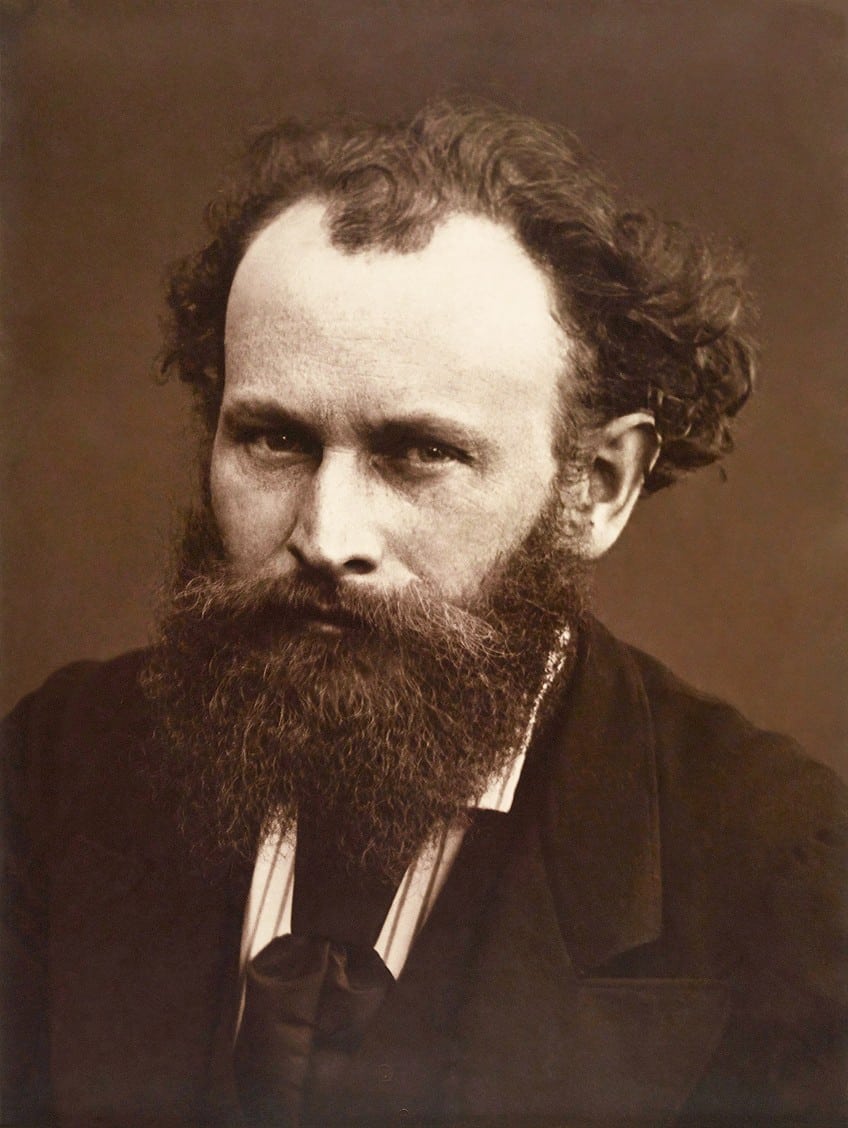
While some of his artworks were rejected for exhibition by the famous Paris Salon, he nonetheless exhibited in other spaces and the Salon des Refusés. The primary themes of Manet’s art included modern, everyday, subject matter like urban scenes and people’s lifestyles.
Some of his famous artworks include “The Absinthe Drinker” (1859), “Olympia” (1863), and “The Fifer” (1866).
A Bar at the Folies-Bergère (1882) by Édouard Manet in Context
| Artist | Édouard Manet (1832 – 1883) |
| Date Painted | 1882 |
| Medium | Oil on canvas |
| Genre | Portrait painting |
| Period/Movement | Impressionism |
| Dimensions (meters) | 96 x 130 |
| Series/Versions | N/A |
| Where Is It Housed? | The Courtauld Gallery, London, United Kingdom |
| What It Is Worth | Valued at over $20 million |
In the A Bar at the Folies-Bergère analysis, you will read more about when Édouard Manet painted it, a look at the bar he chose to paint, who the barmaid was behind the counter, and what the meaning and inspiration for the painting were, of which there have been numerous symbolic interpretations. Additionally, a formal analysis will provide a visual description of the scene including the elements of art composing it.
Contextual Analysis: A Brief Socio-Historical Overview
A Bar at the Folies-Bergère, or Un Bar aux Folies-Bergère in French, was completed in 1882. It is widely mentioned as one of the artist’s last paintings; he died of syphilis in April 1883. It depicts the interior of the famous bar/music hall named Folies-Bergère, which opened in 1869 and is in the 9th Arrondissement in Paris.
It was a festive space that facilitated a myriad of fashions and fancies with entertaining acts that ranged from singing, dancing, and all the way to acrobatics.
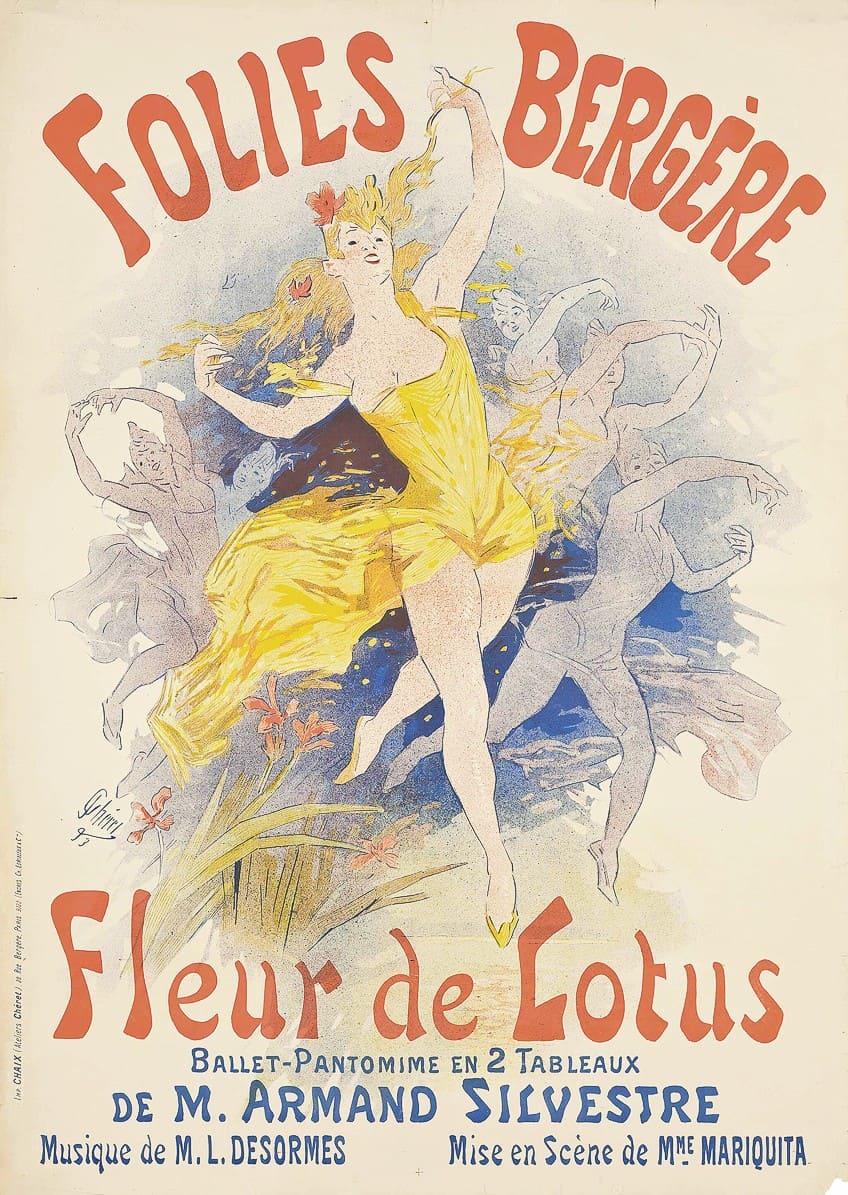
Reportedly, Manet also visited this bar, but he created the painting in his studio and made studies of the scene, which includes the oil painting titled Study for A Bar at the Folies-Bergère (1881). This study depicts the barmaid in a different position to the right of the composition.
Who Is the Barmaid in A Bar at the Folies-Bergère?
While there is minimal information about the woman who modeled for Manet, her name was reportedly Suzon. She was a real barmaid who worked at the Folies-Bergère bar and reportedly also modeled for him at his studio.
A Bar at the Folies-Bergère Meanings
There have been numerous interpretations around the meaning or symbolism of the painting A Bar at the Folies-Bergère by Édouard Manet. For example, the woman, Suzon, appears, seemingly, as two people in the composition.
The one version of her is facing us, the viewers, and is assumed to be in the role of the barmaid who is either waiting for a client to place a drink order or about to serve a drink. She also appears somewhat disinterested or disillusioned and in her own thoughts, evoking a sense of curiosity in us, the viewers, as to what she might be experiencing.
The other version of her is the one with her back to us, which is her reflection. She appears to be slightly leaning on the counter and somewhat more engaged even though all we, the viewers, can see is her back. It looks as if she is also talking or engaging with the man, who is also reflected in the mirror. There is an ambiguous interpretation of Manet’s reflection. Could it simply be Suzon’s reflection and she is taking a drink order from the man? Or could this be another reflection together, of activities that were more under the counter, that Manet alluded to?

Suzon’s reflection could allude to the idea that she is a prostitute, and the man reflected, a potential customer. In fact, the Folies-Bergère bar was frequented by prostitutes, and Manet’s painting touches on these ideas of women presenting themselves in that space and what they had to offer their male patrons.
Other symbolic motifs include the oranges in the bowl on the bar to the left. These have been thought to symbolize prostitution, notably by the artist himself.
Manet was reportedly known for depicting fruit in his other paintings, for example, his famous Le Déjeuner sur L’Herbe (c. 1862) or Luncheon on the Grass painting depicts a basket of fruit in the lower left corner. Similarities and inspirations for Manet’s reflection effects in his painting A Bar at the Folies-Bergère have been drawn between the painting Las Meninas (1656) by the famous Spanish Golden Age artist Diego Velázquez. Interestingly, Manet reportedly loved the Spanish culture and was influenced by Diego Velázquez’s art style which included a more expressive manner of painting.
In Velázquez’s painting, the artist also plays on reflections – who is looking at who, so to say. This is evident in King Philip IV and Queen Mariana, who are reflected in a mirror on the back wall, but who are not in actual view in the composition itself. The scene also depicts the artist, who is looking at us, the viewers, while he is in the act of painting the scene.
Formal Analysis: A Brief Compositional Overview
A Bar at the Folies-Bergère formal analysis will first introduce the subject matter by description This will be discussed further in terms of how the art elements like color, texture, line, shape, form, and space compose the painting.

Subject Matter: Visual Description
A Bar at the Folies-Bergère by Édouard Manet depicts a woman, or the barmaid, standing behind a bar with both hands leaning on its edge exposing the inside of her wrists. Her gaze is somewhat listless and empty, and her eyes are turned to what appears to be an unknown object in front of her to her right (our left).
Behind her is what appears to be a large gilded framed mirror, which reflects her back to us, the viewers. It also reveals a man standing on what is assumed to be the other side of the bar. He is standing slightly opposite the barmaid’s reflection and to the right edge of the composition.
However, it assumed he is standing where the viewer is standing, which would place him on the left side. He does not appear to be looking at the barmaid and is possibly gazing at himself or what is occurring behind him. He is wearing a black top hat and there is a walking stick in his left hand (our right). The items on the bar in the foreground include several bottles of alcohol, of which some have been identified as champagne, wine, liqueur, and beer, notably a popular beer of the time from the British beer company called Bass Brewery. Other items on the bar top include a vase with flowers and several oranges in a glass container.

The background consists of a reflection of what the barmaid would see in front of her. This depicts a crowd of people engaged in the entertainment around them, for example, in the top left corner are two dangling legs and feet with green shoes on what appears to be a trapeze artist. There is also a woman sitting on the edge of what appears to be a stage looking through her binoculars and just to her right (our left) is a woman in white, who appears to be the only woman wearing white and she stands out of the crowd.
Color
The color scheme of A Bar at the Folies-Bergère by Édouard Manet consists of blacks, dark to lighter blues, browns, grays, whites, and patches of reds, oranges, and greens from the objects in the foreground and the lighter green of the trapeze artist’s shoes.

The color scheme for A Bar at the Folies-Bergère is a cooler color temperature and there is a contrast of light and dark, notably the large blue-black area of color of the barmaid’s outfit and the scattered patches of light and dark around her.
Texture
There is implied and tactile texture in A Bar at the Folies-Bergère by Édouard Manet. The implied texture appears in the smooth skin of the oranges, the glistening glass of the bottles of alcohol, the hardness of the bar’s surface, and the fineness of the lace on the barmaid’s collar. Tactile texture is visible in Manet’s expressive brushstrokes, which appear in a variety of sizes and thicknesses.
This was a characteristic of Manet’s painting style, which also creates a dynamism in the composition.
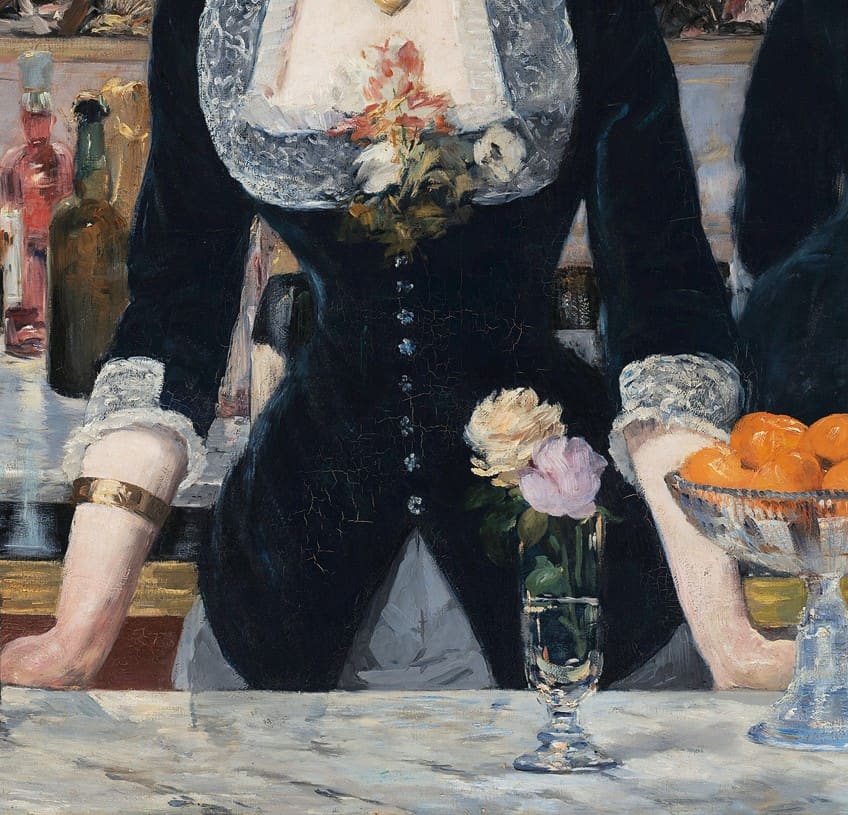
Line
There are varieties of lines in A Bar at the Folies-Bergère by Édouard Manet, which are evident from the brushstrokes and the lines creating the shapes and forms of the subject matter. Some of the lines are the straight and long horizontal lines in the background reflection, the round lines delineating the oranges, the angular, more squared, lines of the barmaid’s collar, and the irregular and curved lines of the bottles.

Shape and Form
Line as an art element creates shape and form in a visual composition. There can also be different types of shapes and forms, ranging from naturalistic or organic, which appear irregular or asymmetrical. Another type of shape and form can be geometric, which is more angular and symmetric. Furthermore, shapes occur more as two-dimensional and forms as three-dimensional, which are created by other art elements like color to create depth through contrasts of light and dark.
“A Bar at the Folies-Bergère” depicts some two-dimensional shapes, for example, the two whitish circles, that appear to be lights, in the background on the rectangular columns or the more three-dimensional spherical forms of the oranges in the foreground.

The bottles in the foreground, with curved and straight lines, appear as irregular forms. Notice the triangular shape created from the bottom of the barmaid’s jacket, where her buttons end, that reveals her skirt underneath.
Space
Space is a significant art element in the painting A Bar at the Folies-Bergère by Édouard Manet. This art element is all about how the compositional “area” is utilized, which Manet evidently played with, exploring the spatial perspectives, notably through the mirror’s reflection. Some scholars have also indicated that Manet utilized a one-point perspective.
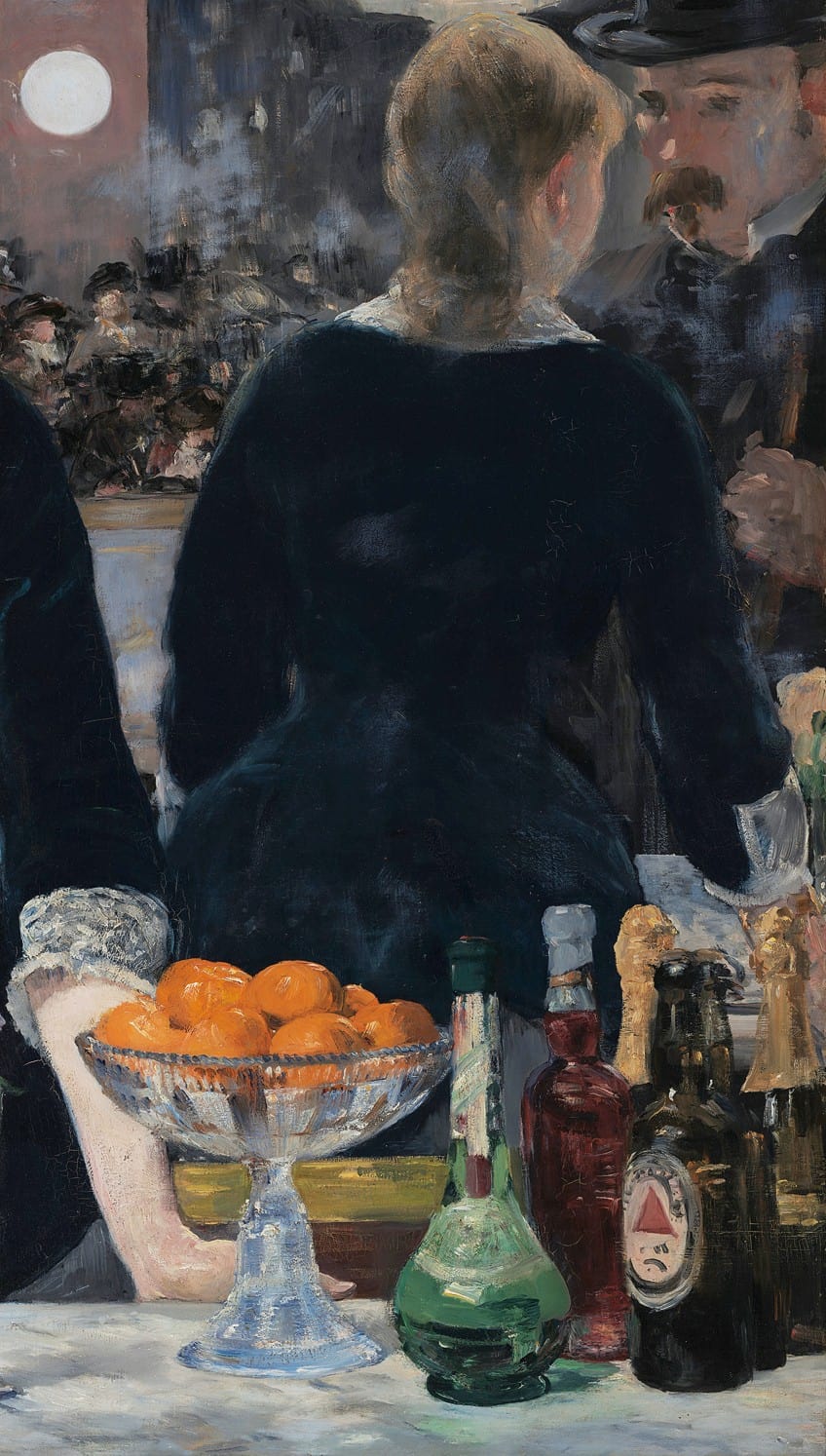
A three-dimensionality, or depth, is also conveyed through techniques like scale and blurring. For example, the figures in the background appear smaller and less defined, and almost blurred, notably in the distant background, where the figures appear as indistinct black lines. These are contrasted with the figures in the middleground and foreground, who appear more defined and distinct, especially the barmaid and man reflected in the mirror.
A Barmaid Come to Life
A Bar at the Folies-Bergère by Édouard Manet, or in French Un Bar aux Folies-Bergère, has become an iconic painting that was not only influenced by the artist’s own artistic interests and techniques but continued to influence contemporary pop culture long after Manet’s death.
Several often-mentioned examples include the film, “Coming to America” (1988), where the painting can be viewed as a parodied and replicated painting, which depicts a black woman standing behind a counter, on which is a hamburger on a plate.
The composition was also brought to life in the film The Private Affairs of Bel Ami (1947), where a scene models the woman behind the bar as seen in the painting. The ballet, Bar aux Folies-Bergère (1934), which was choreographed by Ninette de Valois, also brings the woman behind the bar to life.
While there are extensive studies and theories about this painting, the “A Bar at the Folies-Bergère” analysis above touched on the origins, inspirations, and artistic techniques that made Manet’s 1882 painting a scene that was successfully and forever etched in the memory of art history and culture. It explored one of the most ambiguous portrayals of a woman, and how a seemingly simple reflection in a mirror can create such a striking effect.
Frequently Asked Questions
Who Painted the Woman Standing at the Bar?
Édouard Manet painted the oil canvas, A Bar at the Folies-Bergère (1882), which is the famous portrait of a woman standing at a bar. It is located at the Courtauld Gallery in London, in the United Kingdom.
What Is the Meaning of A Bar at the Folies-Bergère?
There are multiple meanings surrounding A Bar at the Folies-Bergère by Édouard Manet. Some meanings include the allusion to prostitution, and that the woman and man’s interaction reflection is regarded to be more than just a serving of drinks.
Who Is the Woman in A Bar at the Folies-Bergère?
Manet utilized the model named Suzon, whom he painted in his studio. She was also reportedly a real barmaid at the Folies-Bergère bar in Paris.
Alicia du Plessis is a multidisciplinary writer. She completed her Bachelor of Arts degree, majoring in Art History and Classical Civilization, as well as two Honors, namely, in Art History and Education and Development, at the University of KwaZulu-Natal, South Africa. For her main Honors project in Art History, she explored perceptions of the San Bushmen’s identity and the concept of the “Other”. She has also looked at the use of photography in art and how it has been used to portray people’s lives.
Alicia’s other areas of interest in Art History include the process of writing about Art History and how to analyze paintings. Some of her favorite art movements include Impressionism and German Expressionism. She is yet to complete her Masters in Art History (she would like to do this abroad in Europe) having given it some time to first develop more professional experience with the interest to one day lecture it too.
Alicia has been working for artincontext.com since 2021 as an author and art history expert. She has specialized in painting analysis and is covering most of our painting analysis.
Learn more about Alicia du Plessis and the Art in Context Team.
Cite this Article
Alicia, du Plessis, ““A Bar at the Folies-Bergère” by Édouard Manet – A Look.” Art in Context. September 27, 2023. URL: https://artincontext.org/a-bar-at-the-folies-bergere-by-edouard-manet/
du Plessis, A. (2023, 27 September). “A Bar at the Folies-Bergère” by Édouard Manet – A Look. Art in Context. https://artincontext.org/a-bar-at-the-folies-bergere-by-edouard-manet/
du Plessis, Alicia. ““A Bar at the Folies-Bergère” by Édouard Manet – A Look.” Art in Context, September 27, 2023. https://artincontext.org/a-bar-at-the-folies-bergere-by-edouard-manet/.







